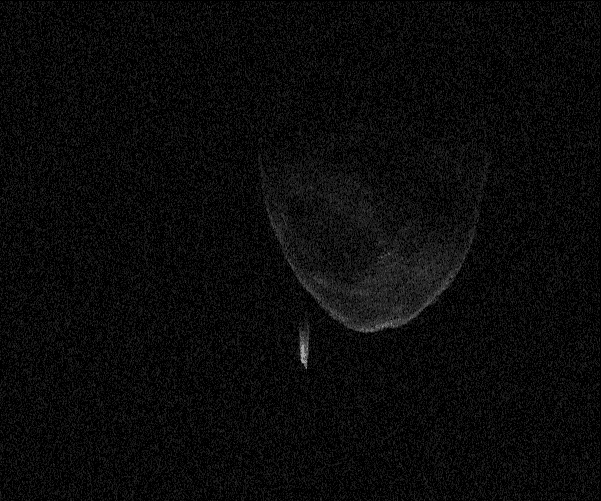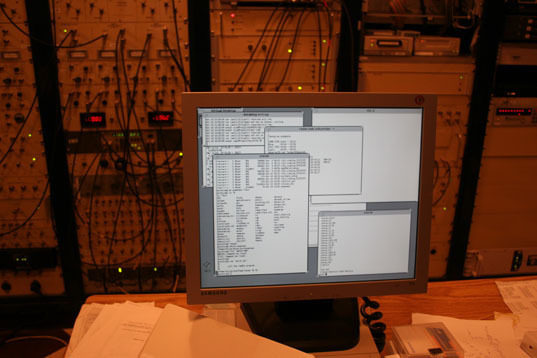Alessondra Springmann • Jun 24, 2013
How radar really works: The steps involved before getting an image
Arecibo Observatory is known for its 305-meter (1000-foot) diameter telescope and its appearances in Goldeneye and Contact. Aside from battling Bond villains and driving red diesel Jeeps around the telescope (grousing at the site director about the funding status of projects is optional), several hundred hours a year of telescope time at Arecibo go toward radar studies of asteroids. A group of four planetary radar astronomers at Arecibo (as well as collaborators and colleagues at institutions outside of Puerto Rico) is tasked with “finding them before they find us” by NASA's Near-Earth Object Observation program. We study the orbits and surface properties of our rowdy neighbors, near-Earth asteroids.

Asteroid radar as we know it started in 1998 at Arecibo Observatory with a big equipment upgrade. A six-story Gregorian dome (the big quasi-spherical structure hanging off of the suspended platform) was installed on the platform that hangs 150 meters (500 feet) above the dish. Previously, line feed antennas (like the one on the left, above) collected signals from radio sources. Line feeds worked fine, very narrow bands of radio detections. This is not so great for astronomical applications, which require wider bandwidths.
The Gregorian dome contains two matte mirrors to focus radio waves in (or out, as is the case with the transmitter) to a set of receivers. A variety of receivers, chilled with compressed helium, receives the radio waves, measuring them in units of volts (really, Arecibo is the world's largest voltmeter). The instruments can receive at frequencies ranging from from 47 Megahertz up past 10 Gigahertz to investigate all sorts of astronomical and atmospheric phenomena.

A powerful set of radio transmitters called klystrons also live Inside the Gregorian dome. Klystrons are like light bulbs for radio waves: they are used for creating and amplifying radio signals for everything from weather radar to particle accelerators (like at the Stanford Linear Accelerator Center, SLAC). Unlike measly 100-watt light bulbs, our klystrons generate 500 kilowatts each in the radio part of the spectrum. They require vacuum tubes and magnets to keep their electron beams aligned. So, a little more complicated than light bulbs.
Klystrons transmit linearly polarized radio waves, which need to be turned into circularly polarized waves. Received echoes are turned from circularly polarized light back into linearly polarized light. The devices responsible for this radio frequency engineering magic are known as septum polarizers and turnstile junctions. Seriously, take a look at these things, they're pure black magic.
The process of observing, which we refer to as "experimenting," is very different at Arecibo than it is for an optical telescope. We observe in the rain, in the fog, and during the daytime. Radar's like the honey badger, it simply doesn't care.
Radar is also active: we transmit radio waves at our targets, then wait for the return echoes. This is unlike passive astronomy, where you wait for light that originated hundreds, thousands, millions, or billions of years ago, or observe photons from the Sun reflected off of objects in the solar system. Instead, we create the photons that we ultimately collect.
A lot of time with optical telescopes is spent taking calibration data. With radar, however, we know exactly what our signal is like that we transmit, which makes the calibration process part of transmitting and receiving, so we don't have to spend extra time observing comparison stars or solar analogs.
We send a powerful pulse of radio waves from our klystrons in the Gregorian dome that then reflects off of the dish and bounces off of passing asteroids. The echoes reflect off the dish, into the Gregorian dome, and just before they come back, we turn off our transmitter and use a sensitive radio receiver to collect the radio echoes from the asteroid.
Nights, or technically "observing runs," start with switching on diesel generators on the other side of the site. The telescope operator takes a 1972 diesel Jeep CJ, shoves in the sticky clutch, and drives over to the maintenance side of site to start the generators. Diesel fuel is the biggest single cost toward running the planetary radar system at Arecibo. The generators create 60,000 volts at 33 amps that travel along a high voltage cable to the Gregorian dome and the klystrons. That high voltage turns into two megawatts of power, one megawatt that we dump as waste heat via 300 gallons a minute of water pumped through cooling tubes from a homebrew setup.
Half of the remaining megawatt, 500 kilowatts, goes to power each klystron, and eventually, out to the asteroid. We transmit the equivalent of 10^13 watts of power (isotropic equivalent), and receive 10^-7 watts back - that's one part in 10^27 that we detect. Granted, we're sort of cheating: Arecibo has 10^7 of gain due to the immense size of the dish.
While observing, we have a telescope operator who makes sure the telescope is pointed properly, as well as a transmitter operator. The transmitter operator keeps track of the magnets, currents, and voltages, to ensure that we are not frying the vacuum tubes with the electron beams.

The high voltage and klystron system is complex, and things go wrong. Finding klystron engineers is difficult, because most of them are retired. Troubleshooting techniques involve manually overriding the high voltage transformer switch with a piece of wood, replacing 250-watt light bulbs, pouring more deionized water into the cooling system, and giving the high-voltage power supply the stinkeye. The latter works surprisingly well.
Getting the returned radio signals out of the telescope is another kettle of fish. We technically collect signals as voltages, not as power, so we can downconvert, frequency shift, filter, amplify, and otherwise manipulate our echoes before officially “observing” them as a vanishingly small fraction of a watt. Signals travel through a thicket of BNC (coaxial) cables and eventually into a vintage Sun Sparcstation.
Once we've collected the echoes of our transmitted signal, we run fast Fourier transforms on them to get a power spectrum of the returned waves. A lot of UNIX commands later, and after downloading multi-gigabyte files and uttering oaths at Sun keyboards, you get a totally sweet image.

And then you do (a) science! But that's a story for another day.
Background image credit: ~Shiranai
Support our core enterprises
Your support powers our mission to explore worlds, find life, and defend Earth. You make all the difference when you make a gift. Give today!
Donate

 Explore Worlds
Explore Worlds Find Life
Find Life Defend Earth
Defend Earth






